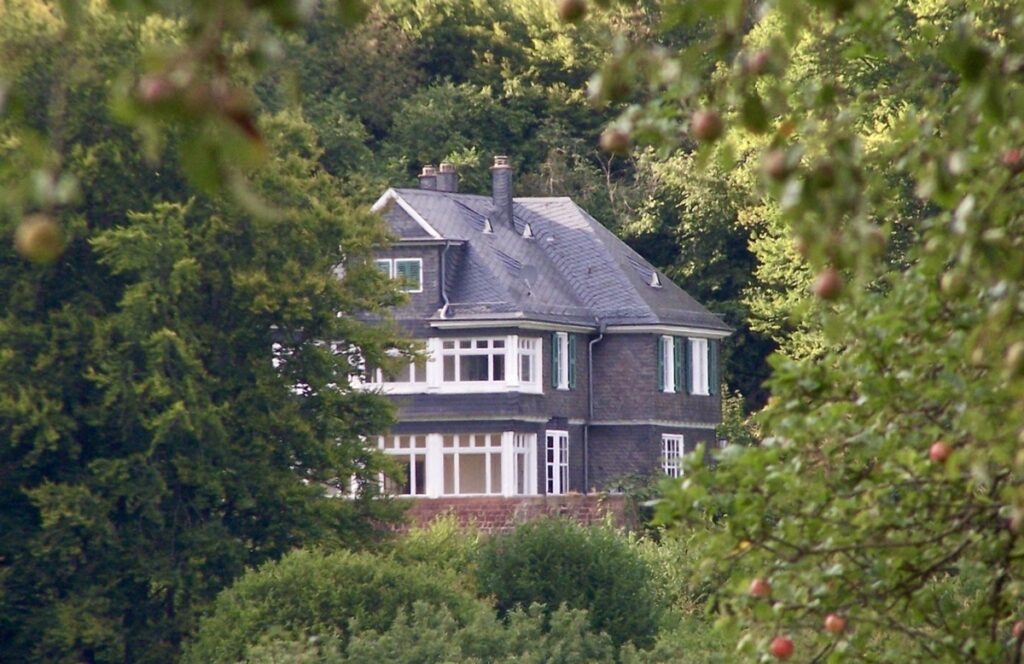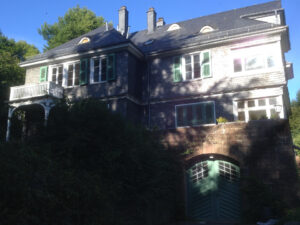
Villa Braunbehrens
The Braunbehrens Villa (also known as Café Ehmann) is a listed building in Kohlhof, which administratively belongs to Heidelberg’s old town but is located three kilometers southeast of the city on the Königstuhl ridge. The building has been owned by the city for many years, has been inhabited by several artists throughout its history and has also been used for gastronomic purposes.
The building was constructed in 1912/14 for Anna Maria von Braunbehrens. She was a cousin of the art patron Karl Ernst Osthaus. Suffering from heart disease and widowed at an early age, she came to the spa hotel in Kohlhof for a stay and decided to settle in the neighbouring community. She had a villa constructed at the edge of the forest, north of the existing residential development. The architect was a student of Henry van de Velde, with whom Anna Maria maintained a lifelong friendship. The design of the house is based on several of van de Velde’s buildings: the Hohenhof in Hagen and the Haus Hohe Pappeln in Weimar. The villa was not built in the typical inconspicuous regional way, but in the style of the time with some echoes of Jugendstil here and there..
The Anna von Braunbehrens ran a small poultry farm, for which a separate chicken coop was built above the Kohlhof forest house. When she left and moved to Handschuhsheim in 1940, the villa was rented to IG Farben, which also acquired the nearby spa hotel and operated a secret research facility there. The villa served as the director’s residence.
 From 1945 to 1950, the composer Wolfgang Fortner lived in the building. He gathered a group of young musicians and composers around him there. These included Klaus Loeffelholz von Colberg, Hans Werner Henze, Hans Zehden, Hans Ulrich Engelmann, Wolfgang Ludewig, Günther Becker, and Ernst-Ulrich von Kameke. Fortner familiarized his students with composers who were frowned upon during the Nazi era, such as Paul Hindemith, and taught them contemporary composition techniques. Together, they listened to and played their own compositions and engaged in lively musical exchange. Contemporaries mockingly called the gathering musicians the Kohlhof Club, and Berlin critic Hans Heinz Stuckenschmidt even described the Kohlhof as a marshalling yard for young composers. Ultimately, however, Fortner’s most successful compositions were written at the Kohlhof, including his violin concerto, the Shakespeare Songs, and the Symphony 1947. The young Hans Werner Henze received the musical influence for his work there, which would soon surpass that of his teacher Fortner after 1950.
From 1945 to 1950, the composer Wolfgang Fortner lived in the building. He gathered a group of young musicians and composers around him there. These included Klaus Loeffelholz von Colberg, Hans Werner Henze, Hans Zehden, Hans Ulrich Engelmann, Wolfgang Ludewig, Günther Becker, and Ernst-Ulrich von Kameke. Fortner familiarized his students with composers who were frowned upon during the Nazi era, such as Paul Hindemith, and taught them contemporary composition techniques. Together, they listened to and played their own compositions and engaged in lively musical exchange. Contemporaries mockingly called the gathering musicians the Kohlhof Club, and Berlin critic Hans Heinz Stuckenschmidt even described the Kohlhof as a marshalling yard for young composers. Ultimately, however, Fortner’s most successful compositions were written at the Kohlhof, including his violin concerto, the Shakespeare Songs, and the Symphony 1947. The young Hans Werner Henze received the musical influence for his work there, which would soon surpass that of his teacher Fortner after 1950.
From 1959, Heidelberg restaurateur Karl Ehmann was the tenant of the building. He already ran the well-known ship restaurant on the Neckar in Heidelberg’s Neuenheimer Ufer and set up Cafe Ehmann in the Kohlhof villa. The café became a popular destination, especially as the Kohlhof had become Heidelberg’s winter sports area in the post-war period. From the 1950s onwards, cross-country skiing competitions were held there, a ski jump built in 1948 on the edge of the Kohlhof meadow offered competitive athletes training opportunities, and the Heidelberg Youth Ski Days were considered a talent factory for the region. The elevated café offered a panoramic view of the winter activities. The seats on the (later glazed) terraces were particularly popular. The popular café received a further boost from the rehabilitation clinic built in the immediate vicinity in 1951 as an extension of the former spa hotel, whose patients and visitors only had to walk a few meters to the café. Inside, the café was equipped with tiled stoves and paneling, and the furniture was solidly crafted. In addition, the building was surrounded by a large park-like garden, which offered additional seating in the greenery around the house in summer.
Around 1970, the villa became the property of the city of Heidelberg. Mayor Reinhold Zundel finally advocated leasing the building at a low price to the sculptor Klaus Horstmann-Czech, who lived there until March 2016. Since then, the house has stood empty.